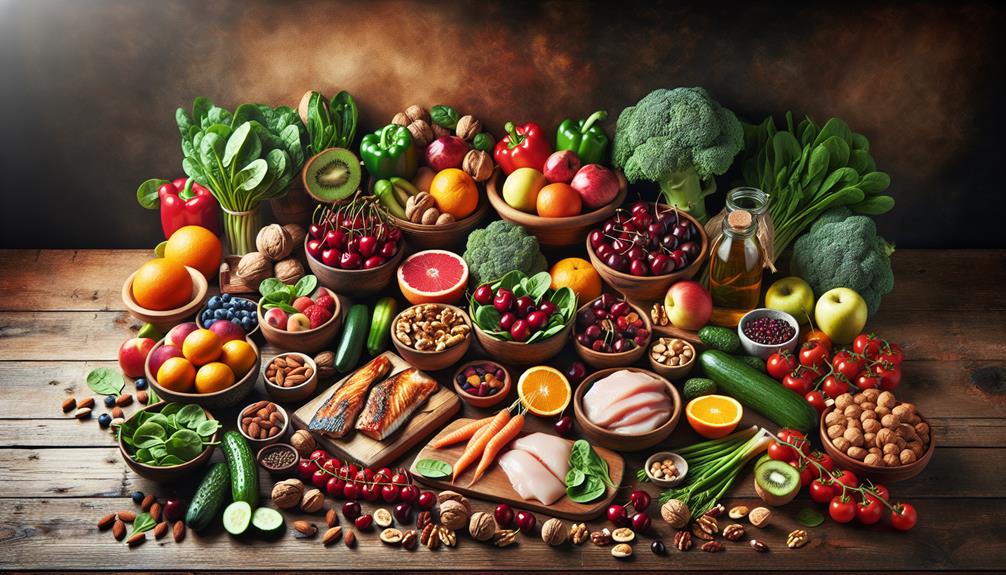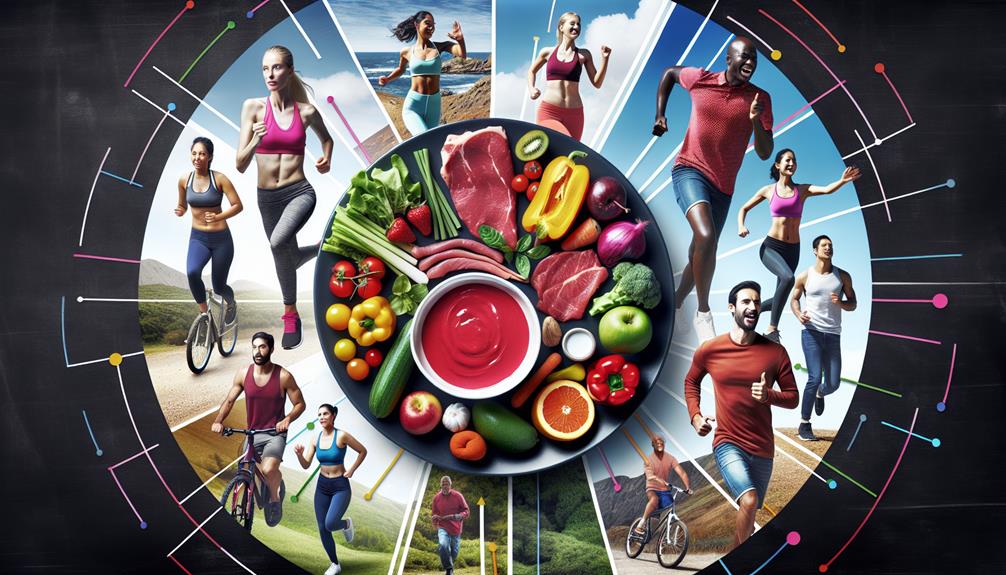Have you ever wondered what it would be like to eat like our ancestors? The Paleo diet offers a glimpse into the past, a way of eating that mimics the diets of our hunter-gatherer ancestors. But what exactly does it entail? What are the key principles, the foods to eat, and the foods to avoid? And most importantly, what are the benefits of following this ancient way of eating? In this discussion, we will demystify the Paleo diet and uncover its secrets, providing you with a comprehensive understanding of how to nourish your body like our ancestors did.
Key Takeaways
- The Paleo Diet is based on the belief that our modern diet contributes to chronic diseases and that our bodies are genetically adapted to the foods of our ancestors.
- The diet focuses on eating whole, unprocessed foods, prioritizing protein, and emphasizing healthy fats while eliminating grains, legumes, dairy, and processed foods.
- By following the Paleo Diet, individuals can experience improved digestion, weight loss, reduced inflammation, and positive impacts on joint pain, skin issues, and autoimmune diseases.
- The Paleo Diet promotes overall better health and well-being by returning to a hunter-gatherer lifestyle and consuming nutrient-dense foods.
Origins of the Paleo Diet
The Paleo Diet originated in the early 1970s when Dr. Walter L. Voegtlin, a gastroenterologist, popularized the idea of eating like our Paleolithic ancestors for optimal health and nutrition. Dr. Voegtlin believed that our modern diet, with its emphasis on processed foods and grains, was a major contributor to chronic diseases such as obesity, diabetes, and heart disease. He argued that our bodies are genetically adapted to the foods our ancestors ate during the Paleolithic era, which lasted from about 2.6 million to 10,000 years ago.
The evolutionary basis of the Paleo Diet lies in the idea that our ancestors had a hunter-gatherer lifestyle, relying on wild plants and animals for sustenance. They did not consume grains, legumes, dairy, or processed foods, as these were not available to them at the time. Proponents of the diet believe that by mimicking the eating habits of our Paleolithic ancestors, we can optimize our health and prevent chronic diseases.
However, it is important to note that the modern interpretation of the Paleo Diet has evolved over time. While the original diet focused on consuming lean meats, fruits, vegetables, and nuts, many people now include certain dairy products and foods like sweet potatoes and quinoa in their version of the diet. Additionally, the diet has been criticized for its exclusion of whole grains and legumes, which are rich in nutrients and have been associated with numerous health benefits.
Key Principles of the Paleo Diet
To understand the key principles of the Paleo Diet, let's now explore its fundamental guidelines for optimal health and nutrition. The Paleo Diet is based on the idea that our ancestors' diet was more suited to our genetic makeup, leading to numerous health benefits. By following these principles, you can experience improved energy levels, weight loss, and better digestion.
Here are the key principles of the Paleo Diet:
| Principle | Explanation |
|---|---|
| Eat whole, unprocessed foods | Focus on consuming real, nutrient-dense foods like lean meats, fish, fruits, vegetables, nuts, and seeds. Avoid processed foods, grains, and refined sugars. |
| Prioritize protein | Include high-quality sources of protein in your meals, such as grass-fed meats, eggs, and poultry. Protein is essential for muscle growth and repair. |
| Emphasize healthy fats | Incorporate sources of healthy fats like avocados, olive oil, coconut oil, and nuts. These fats provide energy and support brain health. |
| Eliminate grains and dairy | Grains and dairy are excluded from the Paleo Diet due to their potential inflammatory effects and the presence of lactose, which many people have difficulty digesting. |
| Stay hydrated | Drink plenty of water throughout the day to support optimal digestion, hydration, and overall health. |
Foods to Eat on the Paleo Diet

When following the Paleo Diet, it is important to focus on consuming a variety of nutrient-dense, whole, unprocessed foods. This way of eating emphasizes the types of foods our ancestors would have consumed during the Paleolithic era. By focusing on whole, unprocessed foods, you can maximize the nutritional value of your meals and support your overall health and well-being.
Here are three key food groups to include in your paleo diet meal plan:
- Lean Protein: Include sources like grass-fed beef, free-range poultry, wild-caught fish, and eggs. These proteins are rich in essential amino acids and can help support muscle growth and repair.
- Fruits and Vegetables: Fill your plate with a variety of colorful fruits and vegetables. These provide essential vitamins, minerals, and antioxidants while adding flavor and diversity to your meals.
- Healthy Fats: Incorporate sources like avocados, nuts, seeds, and olive oil. These fats provide energy, support brain function, and help maintain healthy cholesterol levels.
The paleo diet has gained popularity as a way to support weight loss. By focusing on whole, unprocessed foods and eliminating processed grains, sugars, and refined oils, you may naturally reduce calorie intake and improve metabolic health. However, it's important to remember that weight loss is a complex process influenced by various factors, and individual results may vary.
Foods to Avoid on the Paleo Diet
To adhere to the principles of the Paleo Diet, it is important to be mindful of the foods that are not recommended for consumption. The Paleo Diet focuses on eating whole, unprocessed foods that our ancestors would have eaten. This means avoiding certain foods that have become staples in the modern diet.
One of the main categories of foods to avoid on the Paleo Diet is processed foods. These include packaged snacks, sugary drinks, and processed meats. These foods are often high in unhealthy fats, added sugars, and artificial ingredients. They provide little to no nutritional value and can contribute to weight gain and chronic diseases.
Another category of foods to avoid on the Paleo Diet is grain products. This includes wheat, rice, corn, and other grains. Grains are a significant source of carbohydrates and can cause spikes in blood sugar levels. They also contain anti-nutrients like phytates and lectins, which can interfere with the absorption of important nutrients.
To help you better understand which foods to avoid on the Paleo Diet, here is a table outlining some examples:
| Processed Foods | Grain Products |
|---|---|
| Packaged snacks | Wheat |
| Sugary drinks | Rice |
| Processed meats | Corn |
| Artificial ingredients | Other grains |
Benefits of Following the Paleo Diet

Following the Paleo Diet can offer numerous benefits for your overall health and well-being. Here are three key benefits that you can expect:
- Improved Digestion: The Paleo Diet emphasizes whole, unprocessed foods that are rich in fiber. By cutting out processed foods, grains, and dairy, you reduce the intake of potential irritants to your digestive system. This can lead to improved digestion, reduced bloating, and better nutrient absorption.
- Weight Loss: The Paleo Diet promotes consuming lean proteins, healthy fats, and plenty of fruits and vegetables. These nutrient-dense foods can help you feel full and satisfied while consuming fewer calories. Additionally, the elimination of processed sugars and refined carbohydrates can help stabilize blood sugar levels and reduce cravings, leading to weight loss.
- Reduced Inflammation: The Paleo Diet focuses on anti-inflammatory foods such as fruits, vegetables, nuts, and seeds. By avoiding processed foods and potential allergens like grains and dairy, you may experience a reduction in chronic inflammation. This can have a positive impact on various health conditions, including joint pain, skin issues, and autoimmune diseases.
Frequently Asked Questions
Can the Paleo Diet Help With Weight Loss?
The Paleo diet can help with weight loss. Many people have shared testimonials about how it has helped them shed pounds. Additionally, studies have shown that the Paleo diet can improve insulin sensitivity, which is beneficial for weight management.
Is the Paleo Diet Suitable for Vegetarians or Vegans?
The Paleo diet may not be suitable for vegetarians or vegans due to its emphasis on animal products. However, there are adaptations that can be made to follow a modified version of the paleo diet for vegetarians or vegans.
Are There Any Potential Side Effects or Risks Associated With the Paleo Diet?
You might be wondering about the potential side effects and risks of the paleo diet. It's important to note that there are some concerns about its impact on long term health.
Can the Paleo Diet Improve Gut Health or Alleviate Digestive Issues?
The Paleo diet, by emphasizing whole foods and eliminating processed ones, can promote healthy digestion and improve gut health. It supports the growth of beneficial gut bacteria, leading to a healthier gut microbiome.
How Does the Paleo Diet Compare to Other Popular Diets, Such as the Ketogenic or Mediterranean Diets?
The Paleo diet differs from other popular diets like the ketogenic or Mediterranean diets. While some may argue that a vegan diet is healthier, the Paleo diet has been shown to have a positive impact on blood sugar levels.
Conclusion
So, if you're looking to improve your health by eating like our ancestors, the Paleo Diet may be worth considering. By focusing on whole, unprocessed foods and avoiding grains, dairy, and processed sugars, you can potentially experience benefits such as weight loss, improved digestion, and increased energy levels. Remember, though, that everyone's body is different, so it's important to listen to your own needs and consult with a healthcare professional before making any major dietary changes. As they say, "You are what you eat."













